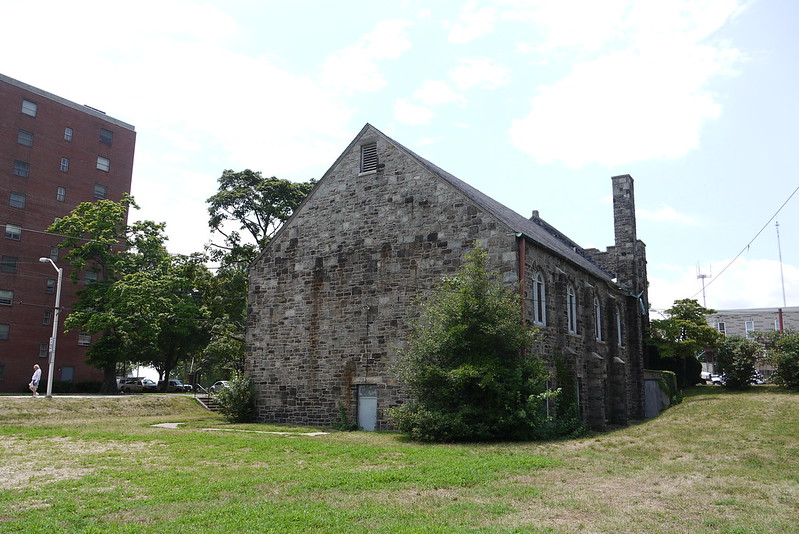Built in 1912 for a congregation that began in 1889, the former Roland Avenue Methodist Episcopal Church is an excellent example of an early 20th century church reflecting the broader history of the Rolden area as a developing suburb during the late 19th and early 20th centuries.
The history of the church began in 1887 when Alcaeus Hooper, then a member of the Woodberry Methodist Episcopal Church, decided that an additional church was required to serve Baltimore residents farther north who were forced to travel a fair distance to services. In August 1887, Hooper purchased a lot at the corner of Central Avenue and 6th Street, now known as Roland Avenue and 40th Street, as a branch of the Woodberry church. Work began on a new frame church building in 1888 and the first service was held in 1889 with Rev. John W. Cornelius as pastor. On April 3, 1889, the new congregation elected its first board of trustees. A Baltimore Sun article marking the 25th Anniversary of the existing building, described the character of the first building:
“It was a typical ‘country church’ that thus came into being in the sparsely settled northern section. A fairly large auditorium, two smaller rooms and a basement for Sunday school activities comprised the facilities in 1903 the trustees acquired the property at 40034 Roland avenue for a parsonage.”
Hooper’s involvement with the church coincided with his own growing involvement in local civic affairs and politics. Born in Baltimore on January 2, 1859, to William Hooper, a significant manufacturer of cotton duck, Alcaeus Hooper was educated in Baltimore, primarily at Lamb’s School. While he continued in his father’s industry as a manufacturer, he became a member of the School Board from 1888 to 1892 and eventually became the Mayor of Baltimore from 1895 to 1897. Hooper remained actively involved with the church during his term as Mayor, as he was elected to the trustees of the church in February 1897.
In 1911, “the timbers of the frame church were found to be unsafe and, under the leadership of the Rev. William C. Parrish, plans were made for a new building.” The church announced a detailed description of the proposed building in April 1911:
“A church building to cost about $20,000 will shortly be erected at Roland avenue and Fortieth street for the congregation of the Roland Avenue Methodist Episcopal Church. It will be of stone and brick and will measure 40 by 60 feet. The seating capacity of the main auditorium will be 350. One of features of the building will be a mothers’ room on the second floor. It will be so situated that mothers sitting there can hear and see the minister in the pulpit. Besides the church building a parsonage will also be erected…
The Sunday-school room in the basement will contain three class rooms, a secretary’s room, a library and kitchen. The building committee consists of Messrs. William Cooney, Walter Franklin, Charles Enterline, Howard R. Salfner, George Hilker, Joseph S. Mixter, John Dixon, J.H. Broomall, Rev. W.C. Parrish and John H. McFaul, Jr.”
The new building was designed by notable architect Alfred Lowther Forrest. Born 1862 in Nottinghill, Middlesex, England, Alfred Lowther Forrest grew up in Surrey and began studying architecture in London by the age of 19. He had moved to New York by 1900 and moved again to Baltimore by 1907 opening his first office at 316 Professional Building, 330 N Charles. His office relocated several times over the years following including the Hoffman Building and the Law Building. By 1920, he lived with his wife Ada, and their three children at 17 Talbot Road. After 1928, Forrest closed his Baltimore office and moved to Rochester, New York where he rented at 193 Park Avenue. Forrest’s notable designs include the Macht Building and the New Theater
The cornerstone for the new church was laid a year later, “in the presence of a large gathering of members and friends,” on April 21, 1912. In 1927, the church closed for a brief period during which new lighting was installed and the interior was redecorated.
Roland Park Place acquired the property from the Roland Avenue Methodist Episcopal Church in March 2001. In March 2010, the building was vacant and threatened with demolition by the proposed expansion of parking for Roland Park Place that proposes the demolition of the 1912 building for 30 parking spots. The issue was brought to the attention of Baltimore Heritage in February 2010 by the publication of a post on the proposed demolition on Baltimore Brew, as well as interest from members of the Baltimore Heritage Preservation Planning committee.


